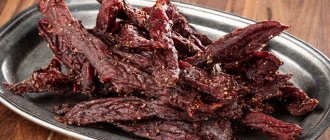It is difficult to imagine modern everyday life without a refrigerator. Ice cellars are a thing of the past or in those rare places where there is no electricity. But, although there is equipment in every home, few people think about what the optimal temperature should be in the refrigerator in order for food to last as long as possible.
There are a number of nuances when it is necessary not only to keep the equipment turned on, but also to adjust the degree of cooling.
Why is controlling the temperature in your refrigerator important?
The duration of preservation of taste characteristics, vitamin content and overall usefulness of the product depends on the temperature. If, for example, eggs are stored at 0–20°C, then they can be safely used for food within 25 days, and at -2–0°C the shelf life increases to 3 months.
Lower temperatures slow down the life processes of microorganisms, which determine whether food begins to spoil or remains fresh for a long time. However, a drop in degree below a certain threshold can spoil supplies just as much as its rise.
At temperatures below -2°C, the egg white begins to freeze, increase in volume, and the shell breaks. There is no need to talk about using or storing such an egg.
Temperature conditions in accordance with GOST
The temperature in a standard Russian-made refrigerator is standardized by GOST 16317-87 “Household electrical refrigeration appliances. General technical conditions". This refers to the values in the center near the chamber wall and the average of those measured in the center, below and at the door.
| Refrigerator class | t°C in the refrigerator compartment | Average t°C in the refrigerator compartment |
| SN | To 10 | 5 |
| N | To 10 | 5 |
| ST | Up to 12 | 7 |
| T | Up to 12 | 7 |
Low-temperature chambers and freezers are produced with freezing down to -6°C (1 star on the label), up to -12°C (2 stars), up to -18°C (3 stars).
The equipment is divided according to the ambient temperature in summer, exceeding which can lead to compressor failure. The maximum value at the rear wall of climate class T devices should not exceed 43°C, class SN, N - 32°C, class ST - 38°C.
Characteristic properties of different manufacturers
No one knows what the ideal temperature in a refrigerator is. For this reason, each of the manufacturing companies unilaterally establishes conditional values for certain models of refrigeration units.
Due to the fact that all food is divided into different categories, each of them is characterized by special savings conditions. Therefore, all people are required to follow the tips for stocking the device with food supplies.
Let's determine what temperature it is customary to set in the refrigerator to maintain the nutritional properties of food:
- Atlas from +3 to +5;
- LG from +2 to +6;
- Indesit from +2 to +8;
- Samsung +3;
- Bosch from +2 to +6;
- Hotpoint Ariston from +3 to +6.
Review of the best refrigerators according to experts
[aiovg_video mp4=»https://kyhni.guru/video/holod-1.mp4"]
As for the temperature regime of the freezer, here everything also depends on the brand of domestic and foreign manufacturers of the refrigeration device. Basically, their range is not very different. Temperature values vary from -18 to -26 degrees.
Storage areas in the refrigerator
The temperature setting that is set on the regulator before turning on the equipment is an average. The equipment will maintain it at this level and the more often the door is opened, the longer the refrigerator will work between shutdowns.
On the refrigerator door
The door is considered the warmest zone. A temperature range of 5–10°C is maintained, starting with a minimum at the bottom. A tray is placed below for storing water, juices, milk, and a little higher - for sauces, mustard, chocolate, jam.
On the top shelves
According to the laws of physics, warm air tends to rise, which means that on the upper shelves the temperature will be above average. Values can range from 7 to 10°C, which is favorable for storing cheeses, smoked products, confectionery, and sweets.
At the central office
At an average level, 4–6°C is maintained - these are the best conditions for milk, salads and other ready-made dishes.
On the lower shelves
The lower tier is cool, at 2°C. The shelves are suitable for dairy products, vegetables, fruits and meat, fish or semi-finished products from them.
In vegetable boxes
Drawers for greens and vegetables are placed directly above the freezer. This is the coldest zone with an air temperature of 0–1°C. It is usually called the freshness zone.
Near the back wall
The temperature at the back of the refrigerator remains low, around 3–4°C.
In the dry cooling section
The dry cooling zone is equipped from the freshness zone, isolating it as much as possible from the chamber space. Conditions are created in the compartment with t from -1 to 0°C and relative humidity up to 50%. Chilled fish and meat can last 2–3 days longer without loss of quality.
In the wet cooling zone
An area with high humidity 90% and t 0–1°C is favorable for preserving the freshness of vegetable products. It is better to place tomatoes, carrots, and cucumbers not in bulk, but in separate containers.
In the freezer
The main operating temperature in most refrigerators is maintained at -18°C. Freeze mode provides -20 to -25°C for a short period of time. A freestanding chest freezer can provide a stable -25°C.
Manufacturers recommend maintaining -18°C for continuous operation, and an hour before placing warm products, turn on the reduced temperature mode and turn it off after complete freezing.
Climatic class of equipment
Modern refrigerators are manufactured according to the zonal principle. All countries or their individual territories are classified according to climate characteristics.
For example, for a group of Scandinavian countries, models with a slightly lower thermal insulation rating are relevant. The compressor is also somewhat deformed. And for countries in the hot tropics, more powerful and wear-resistant devices are needed.
It is logical that if the average annual temperature in the room is several degrees higher, the refrigerator will work more intensively. Therefore, a device model for hot countries costs more than a similar one for the Scandinavians.
Follow the instructions for using the refrigerator. If they are violated, the actual temperature reading will not be equal to the nominal temperature for the selected operating mode
Often the compressor runs almost continuously in tropical countries. However, even under such conditions it is difficult for him to provide the temperature corresponding to the selected mode. Which is not surprising when warm air with a conventional temperature of 40 ºС heats the device from all sides.
Refrigerators for tropical countries are slightly more expensive than their counterparts for cold countries. It is difficult to find them on our market, but according to most technical characteristics they look more convincing.
Each product has its own degree
Shelf life largely depends on temperature. Food products vary in storage conditions. In public catering, trade, in catering units in canteens of enterprises, the regimes recommended by GOSTs, Customs regulations and SanPiN are observed.
At home, maintaining the required temperature and humidity is more difficult, so the time frame is significantly reduced. This applies mainly to the cooling chamber. In the low-temperature compartment it is easier to create the desired degree.
Meat
Cut-up chilled meat is stored from several days to 2 weeks at 0–2°C, that is, where it is coldest - in the lower part. The specific figure depends on the type of product:
- beef - 16 days;
- pork - 14 days;
- lamb - 12 days;
- poultry - no more than 5 days.
If the temperature is higher, around 5 or 7°C, the meat will only last a couple of days before it starts to spoil. It is advisable to cook the cut parts of the chicken carcass within the first 24 hours.
After freezing, shelf life increases.
| Type of meat | At -12 | At -18 | At -20 | At -25 |
| Pork | 3 months | six months | 7 months | Year |
| Beef | 8 months | year | 14 months | 18 months |
| Bird | 5 months | 12 months | 12 months | 14 months |
Fish and seafood
Fish loses nutritional value very quickly. When fresh, it can last at -2–0°C for three days, but in a household refrigerator, even on the bottom shelf there are positive values. It is recommended to cook seafood and live fish on the day of purchase or at least within the next 24 hours.
The purchased item may have been in the store for some time. Taking this into account, cooking time is reduced. If you don’t have time to cook, it’s better to freeze it. The fish defrosts quickly. You just need to take into account that this is already the second freeze after it was caught.
Freezer
Based on the number of chambers in the refrigerator, the freezer compartment can be located together with the main department, or separately from it. The latter option is considered more optimal, as it makes it possible to reduce temperature fluctuations due to frequent opening of the door.
The optimal temperature in the refrigerator freezer is -18°C. In case of low load, it is better to set the regulator at -16°C. Due to this, it will be possible to reduce energy consumption. If the freezer is heavily loaded, it is necessary to set the temperature to -20-25°C to prevent food spoilage.
On a note! At high temperatures in the freezer, the compressor operates at full strength. As a rule, this leads to a reduction in its service life.
Types of cooling systems
Cooling systems differ in the types of refrigerants. The various physical properties of the latter underlie circuits involving heat exchangers and capacitors, which force it to circulate and absorb heat from the refrigeration chamber.
Compressor units
The first refrigerators worked by creating excess pressure by a compressor, like most modern household units. Various carbon compounds are used as refrigerants.
Operating principle:
- the compressor compresses the refrigerant, which enters the condenser;
- in the condenser, the refrigerant turns into a liquid state, releasing heat to the environment;
- in the evaporator located directly at the rear wall, the reverse process occurs - the liquid boils and at the same time absorbs a good portion of heat, creating a working temperature inside the chamber;
- the gas flows back into the compressor.
Absorption systems
In an absorption system, ammonia acts as a refrigerant. Its movement occurs due to the absorption of heat in the generator-boiler. The heated ammonia rises into the condenser, from where it enters the evaporator in the form of a liquid. Taking heat from the cooled products, it is sent to the absorber, and then again to the generator.
Absorption plants are quite complex in design and are almost never used at present. In addition, the use of ammonia is quite dangerous.
Thermoelectric installations
As the name implies, the installations operate by heating with electric current. The circuit uses conductors with different structures, which create heat transfer based on the “Peltier effect” principle.
Thermoelectric installations the size of a household refrigerator are still too expensive, so they are produced in small quantities for the needs of cosmetology, medicine, science and technology.
How to measure temperature
The operating temperature of the chamber is measured 5–6 hours after turning on the refrigerator, when it stabilizes. This is done with an alcohol or mercury thermometer for air or liquid. The measuring range of the compact instrument is typically -50°C to +50°C or 0 to +50°C.
How to measure temperature, 2 ways:
- To ensure accurate readings, do not open the refrigerator door during measurement and do not place uncooled food in the chamber;
- The thermometer is placed on an empty shelf of the refrigerator compartment, the door is closed, and after 4–6 minutes the readings are checked;
- Place a glass of water for 2 hours, after which you can use a thermometer for liquids.
The range from 4 to 6°C will confirm the correct operation of the equipment when installed at the middle mark of the mechanical thermostat.
Useful tips
- Do not place food that has not cooled down in the refrigerator (especially soups);
- It is undesirable to open the doors for a long time;
- Clean the freshness area regularly, as debris quickly accumulates there;
- do not abuse the use of maximum modes so that the compressor does not have to work continuously for a long time;
- for freezing vegetables, berries, fruits, it is better to use special bags so that they do not spread after defrosting;
- defrost the refrigerator at the frequency indicated in the instructions.
Ways to adjust the temperature in the refrigerator
Each class of household appliances is equipped with a temperature control unit, ranging from the simplest mechanical to the use of electronics.
Electronic
Electronic regulators are the most convenient to use. They display all readings on the screen, including degrees, running and idle functions. The device operates using an electronic microcircuit, which is very sensitive and allows you to adjust t with a difference of 1 degree. Adjustment is done with a light touch of your finger.
On the display you can always see how many degrees there are in the chamber. Any smartphone user can figure out how to set the desired temperature. Detailed answers to questions about how to decrease and increase t can be found in the operating instructions.
Mechanical
The mechanical device consists of a system of levers and contacts. The operation of the thermostat is based on changes in refrigerant pressure in a corrugated tube adjacent to the evaporator wall.
By rotating the knob or switching levers, the desired level of cooling is set. The control spring is compressed to a certain size. Switching on/off occurs when the length of the corrugation increases/decreases compared to the size of the spring.
Combined or separate
Large refrigerators are equipped with separate thermostats on the cooling and freezer compartments.
Signs of malfunctions and their prevention
The appearance of one of the following symptoms indicates a malfunction in the operation of the household appliance:
- snow and ice accumulate on the walls faster than usual;
- the device is too noisy or, conversely, quieter than usual;
- frozen food is covered in condensation or puddles of water have formed inside the appliance.
If at least one of these signs is detected, then the freezer needs repair.
Timely prevention will help you avoid troubles:
- Once every six months, unplug the camera and completely defrost it. After defrosting, wash and dry the device. This rule also applies to refrigerators with a No Frost system (they are defrosted once a year).
- Check the serviceability of the rubber seals on the doors. Their wear leads to insufficiently tight closing of the doors, an increase in the temperature inside the chamber and the formation of condensation.
- Avoid overloading the device with products and their uneven distribution inside the chamber. Fill the freezer so that there is free space inside.
How long does it take for the refrigerator to reach temperature after defrosting?
The maximum operating time of the refrigerator until the required conditions are created will depend on the workload of the chamber and the set temperature. They speed up the process, including equipment without load. After a couple of hours, the refrigerator will turn off and you can load the chamber.
If you fill the shelves with products as much as possible, the cooling time will take 4–5 hours. If the room is too hot, this will also affect the compressor's ability to produce cold. The back side of the refrigerator can heat up to 70°C or higher, so the equipment is installed away from heating devices.
Cooling systems and controls in different models
Household refrigerators operate on compressors and differ in the use of a static or dynamic cooling system.
The static system can be recognized by the “crying wall” in the upper chamber and the hole for condensate drainage. The evaporator is located behind the rear wall, so moisture freezes during operation of the unit. During the idle period, the ice melts and drops flow down a chute into a special container. Once or twice a year, the equipment is defrosted and preventatively cleaned.
The dynamic system allows, using forced ventilation, to evenly distribute the temperature throughout the entire volume. There is no freezing of water on the back wall, and, therefore, there is no need for a gutter to drain it.
Equipment with the No Frost function is the same system, but equipped with an automatic fan next to the cooling device in the freezer compartment. Thanks to constant air circulation, ice does not form.
Bosch
The German company Bosch equips refrigerators with a dynamic cooling system and smart functions Bosch SuperCooling, NoFrost, FreshSense and VitaFresh to keep food fresh for a long time. With Home Connect support, you can control your refrigerator from your phone screen.
Gorenje
The Slovenian home appliance manufacturer uses NoFrost Plus, MultiFlow 360° and LED camera lighting in its installations. Technology creates the perfect environment for safely storing products without additional energy costs.
Atlant
The Minsk Refrigerator Plant continues to supply Russians with high-quality household appliances. The latest line includes devices with electronic control and LED lighting, a dynamic cooling system and a No Frost function.
LG
LG (LG) refrigerators are supplied by a South Korean corporation. In addition to the dynamic supply of cold air, the equipment is equipped with the functions of self-diagnosis, climate control Multi Air Flow, Total No Frost and Big Freezing Zone (freshness zone). To save food when unplugged, the Bio Shield mode is activated.
Indesit
Indesit, formerly an Italian company, is now owned by an American corporation. The range of equipment includes both small ones with manual defrosting and those with a volume of more than 300 liters and a Direct Cool cooling system.
Various devices use the principles of low frost and no frost, which do not require defrosting instructions. Control can be carried out mechanically or touch-sensitively on the display.
Liebherr
The German company Liebherr uses its own patented BioFresh technology, dividing storage zones into HydroSafe (wet) and DrySafe (dry).
In addition to freezers and refrigerators for domestic use, Liebherr produces laboratory equipment for sensitive substances and ultra-low temperature chambers with cooling down to -80°C. The company also produces commercial equipment for ice cream, deep-frozen products and refrigerated display cases.
Haier
Haier is a Chinese company that specializes in refrigeration equipment. Offers include 2, 3 and 4 door models with Fresher Techs, which divides the space into storage areas with favorable conditions for each type of product.
Thanks to the dynamic Total No Frost cooling system, there is no need for defrosting. Inverter compressors create noise no higher than 38 dB.
Stinol
The Novolipetsk plant specializes in single-chamber and double-chamber equipment with a static cooling system. In order for the device to work properly for many years, you will need to adhere to a manual defrosting schedule.
Samsung
Models are equipped with different types of environmental control. Inexpensive ones have a mechanical regulator, more reputable ones have electronics. In a two-chamber Samsung refrigerator, each compartment is controlled individually.
The devices use a Twin Cooling Plus cooling system with separate evaporators for the cooling and freezing chambers. Multi-door refrigerators are equipped with an independent Flex Zone compartment.
Siemens
The German multinational corporation is at the forefront, integrating the latest refrigeration and temperature control systems into technology. Together with the No Frost technology, the hyperFresh function protects vegetables from drying out, and with the help of SuperFreezing, the unit speeds up the freezing of newly inserted products.
Beko
The Turkish manufacturer supplies refrigerators with a static cooling system and with the No Frost function. The company's technological innovation is Active Fresh Blue Light. The ionizer and antibacterial filter maintain a healthy atmosphere in the chamber.
Biryusa
The Krasnoyarsk plant can offer consumers inexpensive refrigerators with static cold supply, as well as new equipment with a multi-flow supply of cooled air and the Full No Frost function.
The plant supplies medical equipment to medical and scientific institutions of the country. Freezer temperatures down to minus 40 degrees help preserve plasma, biological material, and vaccines.
Electrolux
The Swedes produce modern equipment with uniform distribution of cold, flexible temperature control, and automatic removal of frost in the No Frost freezer.
Ariston
Free-standing and built-in models of the American brand Ariston use forced air circulation to preserve the walls without traces of icing. Temperature Variable Zone, Day 1 Fresh Technology regulates the temperature. Each type of product receives a standardized dose of cold.











